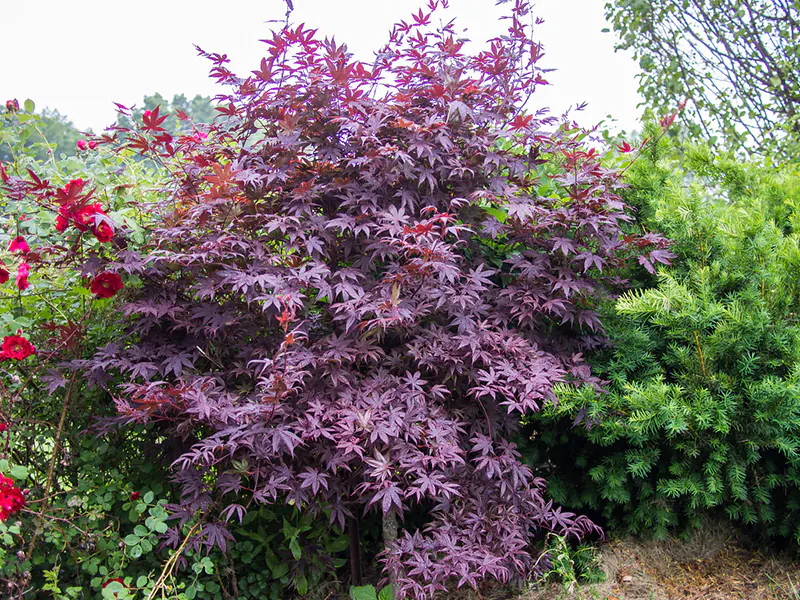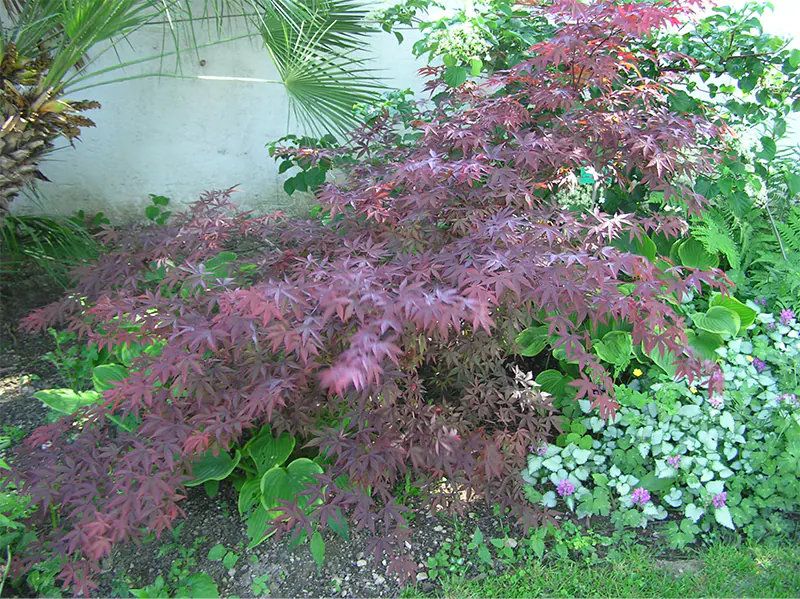Purple Ghost Japanese Maple
The purple ghost Japanese maple is a gorgeous bonsai you can grow at home, whether you have any gardening experience or if you’re entirely new to bonsais. This tree has amazing purple foliage that’s easy to maintain. Within this article, we’ll answer all your questions and concerns, from whether it grows indoors to how to maintain the purple leaves throughout the year.
Image courtesy of F.D. Richards
Here's what you'll find while reading our Purple Ghost Japanese Maple bonsai species guide:
Here's what you'll find while reading our Purple Ghost Japanese Maple bonsai species guide:
01
02
03
04
05
Quick Purple Ghost Japanese Maple Bonsai Care Sheet
If you need a quick reference or overview, the table below is a great help. It’s short but accurate and lists only the bare essentials you need to know before growing a purple ghost Japanese maple.
Recommended soil | Akadama mixture with added pumice and lava rocks. |
Watering | Once a day. |
Potting season | Every second year. |
Shaping and pruning season | Every second year, preferably during autumn. |
Light | Morning sunlight is preferred, but at least a few hours worth each day. |
Fertilizing | Solid organic fertilizer that’s low in nitrogen. |
Propagation methods | Seeds, air layering, and cuttings during autumn. |
Pests and diseases | Aphids and fungal infections. |
How To Care For A Purple Ghost Japanese Maple Bonsai
Caring for any bonsai has a few basics: soil, sunlight exposure, and watering. In this section, we’ll walk you through all that and more. We explain which fertilizer is best, when to repot, and when to prune.
Best Soil
A well-draining option is best when selecting the best soil for your purple ghost maple. However, the akadama mixture with lava rocks and pumice mixed in for optimal growth helps retain more moisture and nutrients while still draining effectively.
This option will help your bonsai thrive while lessening how often you need to water it each day. Adding some lava rocks or pumice to your regular well-draining mixture is also beneficial.
Watering
As the purple ghost Japanese maple is a thirsty bonsai that often needs watering more than once a day, it’s important to check the soil’s moisture. Touch your finger to the soil; if it still feels wet once you’ve plunged your finger in deeply, your tree doesn’t need any more water.
We recommend watering the tree either in the morning or evening, where less will evaporate and has a longer-lasting effect. You’ll often only need to water the tree once a day with proper watering times. At times, a small bit of extra watering may be handy for the bonsai’s health.
Repotting
Every two years, the purple ghost Japanese maple needs to be repotted. Due to its root system, this high frequency doesn’t change as the tree ages. The bonsai’s roots spread and fill the pot within two years, requiring repotting and pruning of the roots.
Use a thing stick to separate the tree’s roots for pruning gently. Clean tools are essential as the trees are prone to fungal infections. Additionally, washing your pot thoroughly before reinserting the bonsai is advised.
Shaping And Pruning
Most of the shaping and pruning can be done throughout the year. However, the tree needs to rest for two years before pruning the leaves and smaller pieces. Over-trimming will harm your tree and hurt its growth.
Autumn is the best time to cut off larger branches. While doing this, a cut-paste is recommended to stop any infections on the exposed part of the tree.
Location And Sunlight
The purple ghost Japanese maple prefers full sun and partial shade for proper growth. However, shading the tree during the summer afternoons is advised. This period of the year often has a hotter sun, harming your tree’s leaves. When possible, morning sunlight is the best for your tree’s growth.
Additionally, the tree will thrive best in a well-aired area but should be adequately spaced away from other trees. This spacing will help manage any pests or diseases that afflict your tree.
Fertilizing
Use a solid organic fertilizer for the purple ghost Japanese maple during the growing season. This option should be low in nitrogen, as too much of this element will cause the leaves to grow faster and appear oversized.
If you’d like a stronger option, mix in liquid fertilizer once a week. While this will provide an extra kick, you should only add liquid fertilizer while your bonsai is healthy.
Propagation Methods
Seeds, cuttings, and air layering are all viable methods for growing a new purple ghost maple. These methods are best done during the autumn months.
Pests And Diseases
Aphids are among the most annoying pests you’ll deal with while growing the purple ghost Japanese maple. These tiny sap-eaters are a nuisance once they turn into an infestation. Fortunately, regular insecticide and misting your tree with water are great ways to get rid of them.
Additionally, your purple ghost Japanese maple is vulnerable to an infection known as verticillium wilt. While incurable, you can manage this infection by trimming away the afflicted areas, providing your tree with nutrients and fertilizer, and keeping it away from other plants to stop it from spreading.

Considerations For Growing An Indoor Purple Ghost Japanese Maple
When growing a purple ghost indoors, you need to pay careful attention to where you keep it. If the tree is left without enough sunlight or in a warm area, it may stunt its growth.
Placement
Watering is your purple ghost’s biggest nightmare, as too much or too little will affect its health. Placement near a window that receives morning sunlight is optimal. During warmer weather, opening the window will provide a cooling breeze that helps maintain the tree’s purple foliage.
Common Issues When Caring For A Purple Ghost Japanese Maple Bonsai
Watering is your purple ghost’s biggest nightmare, as too much or too little will affect its health. Here’s how to manage the issue before it damages your tree.
Watering The Bonsai Too Much
Before watering your bonsai, it’s always best to deeply touch the soil and check for any moisture. However, as this is tedious, it can often be overlooked as you stick to a schedule. With the purple ghost maple, you may develop a habit of watering it twice a day.
You may begin to overwater the tree and harm it in this habit. It’s best to only water once a day and check if the bonsai needs any additional water a few hours later.
Image courtesy of MouMousse13
FAQs About Purple Ghost Japanese Maple Bonsai
Here are four frequently asked questions about the gorgeous purple ghost Japanese maple. We explain the difference between real and fake purple ghosts, the ease of growing the bonsai, and how to maintain purple foliage.
Like many bonsai, the purple ghost Japanese maple can be grown indoors. You’ll need to make a few considerations, such as its placement and the amount of light it needs per day. However, with proper care, the tree will easily thrive indoors.
The purple ghost Japanese maple is a real tree. However, images online show it having blue leaves, which is fake. The real purple ghost has reddish-purple leaves in a lacey cascade that gives it its name.
Bonsai trees may seem needy and hard to care for, and some are. However, trees such as the purple ghost Japanese maple are easy to care for once you know what you’re doing. With the right information, time, and care, you’ll grow a beautiful tree.
The purple ghost Japanese maple turns green often due to the temperature or amount of sunlight it receives. If the tree receives too little sunlight or is placed in the direct summer afternoon sunlight, its leaves will begin to turn green. Additionally, warmer temperatures may turn the bonsai’s foliage green.







